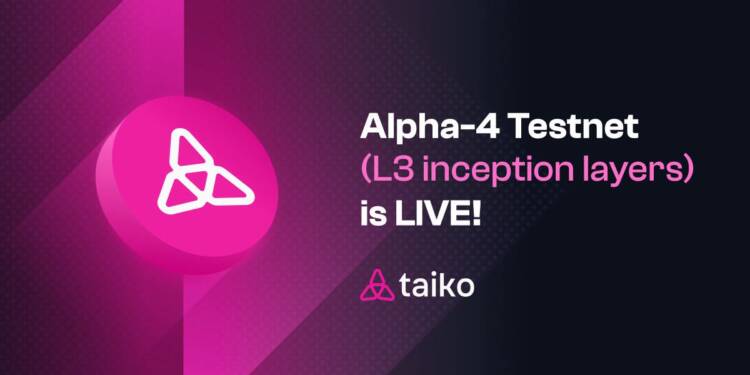In the crypto market, the quest for scalability, efficiency, and security never ceases. The latest entrant in this race is Taiko, a decentralized ZK-Rollup solution, which has recently launched its fourth testnet, Eldfell L3. This launch marks a significant milestone in Taiko’s journey, as it introduces an innovative concept of Inception Layers and tests a new staking-based proving design.
Taiko Brings Inception Layers
In a groundbreaking development, the concept of Inception Layers, a unique feature stemming from the Ethereum-equivalent ZK-Rollup (Type-1 ZK-EVM), is being explored by Taiko. This innovative approach is based on the idea that since Taiko’s Layer 2 (L2) mirrors Ethereum’s Layer 1 (L1), it could be feasible to deploy Taiko on Taiko itself.
What stands out about the inception layers is the unprecedented flexibility they offer in design. It opens up the possibility of deploying Taiko not just as an L2 but also as a Layer 3 (L3) and potentially even further layers, such as Layer 4 (L4). This multi-layered approach could potentially revolutionize the scalability and efficiency of blockchain networks.
Inception layers, a concept introduced by Taiko, involve deploying the same codebase as Layer 3 (L3) on top of Taiko as Layer 2 (L2). This approach, necessitated by the limitations of single rollup scalability, allows for extensive scalability for Ethereum by reusing the same type-1 codebase across multiple layers (L2/L3/L-).
Moreover, the Ethereum-equivalence across these layers ensures powerful features like built-in arbitrary message passing, which helps avoid fragmentation and degradation of user and developer experience. This is achieved through the ability of one type-1 layer to read Merkle proofs from another, enabling seamless communication between different layers.
Taiko’s Alpha-4 Testnet Develops New Prover Mechanism
In a significant development, Taiko has introduced a new staking-based prover economics system with the launch of Alpha-4. This marks a departure from the design of Alpha-3, which operated on a “first prover wins” basis. While efficient, this approach led to potential centralization and compromised liveness, as multiple provers often worked on the same block, but only one received the reward.
The new system aims to address these issues by assigning a proposed block to a designated prover drawn from a pool. This prover is then required to submit valid proof within a specified time window for block verification. Failure to do so results in a penalty, with the prover’s stake being slashed.
The selection of provers for the pool is based on several factors:
- The number of tokens a prover stakes per capacity. The higher the stake, the greater the likelihood of selection.
- The expected reward per block. Provers with higher rewards are less likely to be selected.
- The capacity specified by the prover. The selection of a prover reduces their capacity by one. When the capacity reaches zero, the prover is no longer eligible for selection. However, the capacity increases by one, up to the maximum specified during staking, when a block assigned to the prover is proven.
Due to implementation constraints, the prover pool is limited to 32 provers, with a minimum capacity of 128 per prover required by the protocol.
While the new design supports the top 32 provers with the highest stakes and capacities, it is anticipated that secondary proof markets will further distribute proving tasks to smaller provers, thereby mitigating the risk of centralization.
Taiko is pioneering advancements in Ethereum scalability and efficiency through its innovative Inception Layers concept and the launch of its fourth testnet, Eldfell L3. The introduction of a new staking-based prover economics system aims to prevent centralization and ensure fair task distribution.























